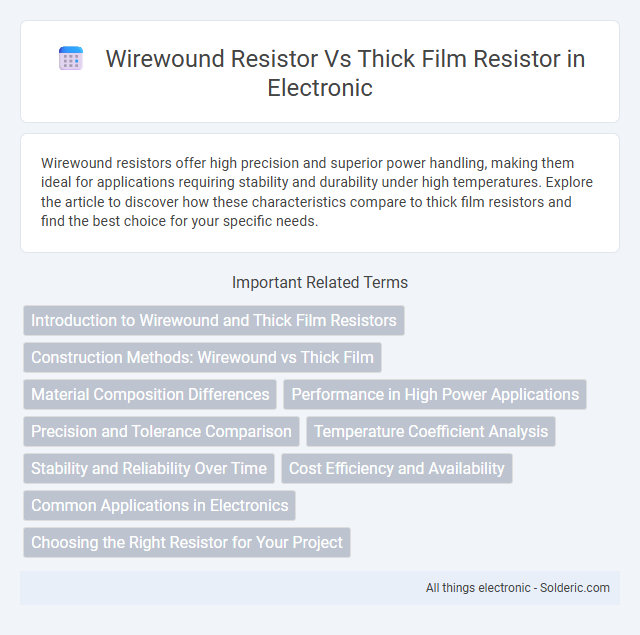Wirewound resistors offer high precision and superior power handling, making them ideal for applications requiring stability and durability under high temperatures. Explore the article to discover how these characteristics compare to thick film resistors and find the best choice for your specific needs.
Comparison Table
| Feature | Wirewound Resistor | Thick Film Resistor |
|---|---|---|
| Construction | Wire coil wound around ceramic core | Resistive paste printed on ceramic substrate |
| Power Rating | High (up to several watts) | Low to Medium (typically up to 2 watts) |
| Resistance Range | 0.1 O to several megaohms | 10 O to several megaohms |
| Tolerance | +-0.1% to +-5% | +-1% to +-5% |
| Temperature Coefficient | Low (+-5 to +-50 ppm/degC) | Higher (+-100 to +-300 ppm/degC) |
| Frequency Response | Excellent (low inductance) | Moderate (higher inductance) |
| Applications | Precision, high power dissipation | General purpose, surface mount devices (SMD) |
| Cost | Higher | Lower |
Introduction to Wirewound and Thick Film Resistors
Wirewound resistors feature a metal wire coil wrapped around an insulating core, offering high precision and stability ideal for high-power applications. Thick film resistors utilize a conductive paste printed and fired onto a ceramic substrate, balancing cost-effectiveness with moderate power handling and tolerance. Your choice between these resistor types depends on the specific electrical parameters and durability requirements of your project.
Construction Methods: Wirewound vs Thick Film
Wirewound resistors are constructed by winding a metal wire, typically made of nichrome or a similar alloy, around an insulating core, providing high precision and power handling capabilities. Thick film resistors are created by screen-printing a resistive paste composed of metal oxides onto an insulating substrate, followed by firing at high temperatures to form a solid film. The wirewound construction offers superior stability and low noise, while thick film resistors allow for compact size and mass production with moderate precision.
Material Composition Differences
Wirewound resistors consist of a metal wire, typically nichrome or tungsten, wound around a ceramic, fiberglass, or plastic core, offering high power dissipation and precision. Thick film resistors are made by depositing a paste of metal oxides onto an insulating substrate and firing it at high temperatures, providing compact size and cost efficiency. Your choice depends on the required tolerance, power rating, and frequency response, as wirewound resistors excel in stability and power handling while thick film resistors suit compact circuits with moderate performance needs.
Performance in High Power Applications
Wirewound resistors excel in high power applications due to their superior power dissipation and low inductance, making them ideal for precision and stability under heavy loads. Thick film resistors, while more cost-effective and offering better tolerance in smaller sizes, typically handle lower power ratings and may experience higher thermal noise and drift under extreme conditions. The choice depends on the requirement for thermal stability and power handling versus size and economic constraints.
Precision and Tolerance Comparison
Wirewound resistors offer superior precision with tolerance levels commonly as low as +-0.1%, making them ideal for applications requiring high accuracy. Thick film resistors generally have wider tolerance ranges, typically between +-1% and +-5%, which suits less stringent precision requirements. The inherent construction of wirewound resistors contributes to their stability and low temperature coefficient, enhancing consistent performance over thick film resistors.
Temperature Coefficient Analysis
Wirewound resistors exhibit a low temperature coefficient of resistance (TCR), typically ranging from +-5 to +-50 ppm/degC, due to their metal wire construction, which ensures stable performance under varying temperatures. Thick film resistors generally have higher TCR values, often between +-100 to +-300 ppm/degC, caused by the ceramic and metal oxide film materials that are more sensitive to temperature changes. Temperature coefficient analysis reveals wirewound resistors are better suited for precision applications requiring minimal resistance variation with temperature fluctuations compared to thick film resistors.
Stability and Reliability Over Time
Wirewound resistors exhibit superior stability and reliability over time due to their metal wire construction, which offers excellent tolerance to temperature changes and mechanical stress. Thick film resistors, while cost-effective and compact, may experience drift in resistance values under prolonged thermal cycling or high humidity conditions. Choosing a wirewound resistor ensures your circuits maintain consistent performance and long-term durability in demanding applications.
Cost Efficiency and Availability
Wirewound resistors generally have higher manufacturing costs due to their precision and durability, making them less cost-efficient for large-scale, budget-sensitive projects compared to thick film resistors. Thick film resistors offer greater cost efficiency and widespread availability, commonly found in mass-produced electronic devices, making them a practical choice for your general-purpose applications. Their production processes allow for cheaper, high-volume output without significant compromise on performance for most uses.
Common Applications in Electronics
Wirewound resistors are commonly employed in high-power applications such as power supplies, motor drives, and audio equipment due to their precise resistance and superior heat dissipation. Thick film resistors are favored in general-purpose electronic circuits including consumer electronics, automotive controls, and telecommunications for their cost-effectiveness, small size, and stability across various environmental conditions. Both resistor types serve crucial roles in circuit protection and signal conditioning within industrial and commercial electronic devices.
Choosing the Right Resistor for Your Project
Wirewound resistors offer high precision and stability, making them ideal for applications requiring low noise and high power dissipation, while thick film resistors provide compact size and cost-effectiveness suited for mass-produced electronic devices. Your choice depends on factors like power rating, tolerance, temperature coefficient, and physical size constraints. Evaluating these parameters ensures selecting the optimal resistor type to enhance circuit performance and reliability.
wirewound resistor vs thick film resistor Infographic

 solderic.com
solderic.com